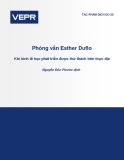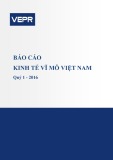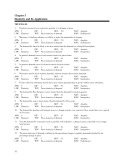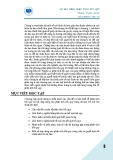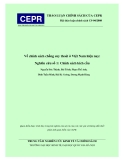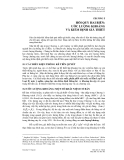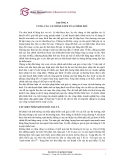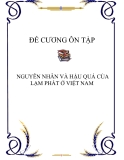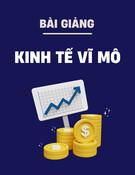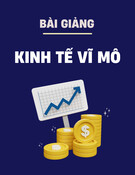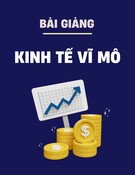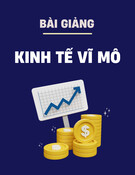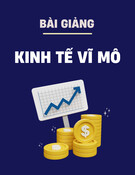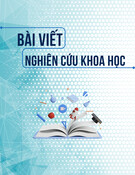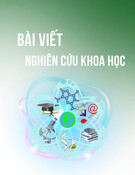
JSTPM Vol 2, No 2, 2013 33
REMOVING CUMBERSOME IN FINANCING SCIENTIFIC
RESEARCH IN UNIVERSITIES IN VIETNAM
THE CASE OF ACADEMY OF FINANCE
M.Sc. Pham Lan Anh
Academy of Finance
Abstract:
In recent years, the Government has implemented a number of policies with specific
measures for promoting science and technology (S&T) development. However, reality
shows that financial investment for S&T activities is still far from expected to meet the
requirements of industrialization and modernization of the country. S&T needs large
financial investment while the resource allocated for S&T from the State budget is limited.
In this difficult context, we have not had, on the other hand, appropriate policies and
mechanisms strong enough to mobilize other non-state funding sources, encourage all
economic sectors to invest in science and technology, especially in technology application.
Particularly, the issue of finding solutions to overcome difficulties in universities caused by
financing mechanism for scientific research is essential to ensure successful contribution of
S&T to the country’s industrialization and modernization. In this paper, the author pointed
out achievements, constraints and the need of provision of appropriate intervention
measures to overcome cumbersome in the current financial regime for scientific research in
universities. Especially, the author proposed groups of solution with a view to improving
the financing mechanism for S&T in universities, in general and in the Academy of
Finance(AOF), in particular.
Keywords: Finance for S&T activities; Financial mechanism; University.
Code: 13081501
1. Introduction
Science and scientific research is a means of fostering economic
development, social progress and has been playing an important role in
socio-economic development of each nation, particularly for Vietnam. In
past years, the Government has implemented a number of policies with
specific measures for promoting science and technology (S&T)
development. However, it was not as expected as the assessment stated in
the Resolution of 2nd Conference of the Party Central Committee, term VII,
on strategic orientation for S&T development in the period of
industrialization - modernization and specific S&T tasks up to 2015, says:
“we have not had appropriate policies and mechanisms to mobilize other
non-state funding sources for S&T development...”. Reality shows that

34
Removing cumbersome in financing scientific research…
financial investment for S&T activities is still far from expected to meet the
requirements of industrialization and modernization of the country. S&T
needs large financial investment while the financial resource allocated for
science and technology from the State budget is limited. In this difficult
context, we have not had, on the other hand, appropriate policies and
mechanisms strong enough to diversify the way of mobilizing other non-
state funding sources, encourage all different economic sectors to invest in
science and technology application.
For a higher education institution, teaching and scientific research are two
basic interrelated and interactive tasks, they are complementary, it may
promote or hinder the development of each other. To improve the quality of
education and training, each teacher must constantly improve the quality of
curriculum by doing research, applying scientific research results in
teaching and learning. One of the factors affecting scientific research
activities of the faculty members is financial mechanism. In practice, there
have been many research works on financial mechanism for scientific
activities in universities and the way to use effectively the resource allocated
to them. The case study of AOF gives us some lessons learnt from the
current financial regime for scientific research in general and for research
activities in universities, in particular. It also suggests that this issue should
be continued to study deeper.
Some key concepts used in this article.
S&T activities is: a system of interrelated activities closely related to the
production, improvement, dissemination and application of science and
technology knowledge in all fields of science and technology, i.e., natural
sciences, engineering and technology, medical sciences and agriculture, as
well as social sciences and humanity (defined by UNESCO).
Scientific research is an activity to detect, understand phenomena, objects,
natural laws, social and thinking; innovative solutions for application in
reality. Scientific research includes basic research and applied research.
2. Present situation of the financial mechanism of Vietnam for scientific
research in universities
There are many approaches to analyze the financial resources for scientific
research in universities. In this article, the author uses the approach of
comparison between direct funding from the State budget and by other
financial resources for analysis. The reasons for using this approach are as
follows:

JSTPM Vol 2, No 2, 2013 35
- Currently, funding for S&T from non-state sources in our country is
still not common. Private companies have almost had not much
investment in scientific research. Funding of State-own enterprises for
S&T is not considerable and mostly comes from State budget, by
nature.
- In reality, finance for S&T in universities is mainly from State budget,
if some research projects the university signed contract with
provincial/city authorities or businesses, most of the funding also has
the origin of the State budget.
- Financial support by foreign organizations for S&T looks significant in
recent years but due to lack of statistics, it is difficult to track records.
In pursuant to the State policy of socialization, diversification of capital
sources for S&T development, financial resources invested in this sector are
increasingly expanding and it attracts the involvement of all economic
sectors, both domestic and foreign:
- Financial resources from the State budget directly allocated to
scientific research in universities include: State Development Fund
managed by the Ministry of Planning and Investment; State scientific
research programs or tasks; Funding allocated for S&T development at
ministries, provinces, cities, and from there channeled to universities.
- In addition, other financial resources for scientific research in the
universities can include: Sale of experimental products such as seed of
crop varieties, livestock, prototype machine and equipment to be used
in production; extra income from research contracts, training services,
rent of technical facilities; part of tuition fee collected, support of
international organizations through collaborative research projects.
3. Assessment of the effectiveness of the financial mechanism for
scientific research activities in universities
3.1. Achievements
- Thanks to the increased investment of the State in building basic
infrastructure of universities and funding for scientific research
activities, the conditions for training/education and scientific research in
universities have been much improved, better meeting the requirement
of learning, teaching and scientific research.
- Teaching staff at universities is increasingly getting empowered with
qualifications improved and more experienced. Every year, hundreds of
teachers in universities receive PhD and Master degree, or granted with

36
Removing cumbersome in financing scientific research…
associate professor and professor title. This means, an additional force
of highly qualified teachers has been added to undertake training and
research activities.
- Universities have made a number of significant contributions to the
country’s industrialization and modernization through carrying out
scientific research programs at State or Ministry level, and through
transfer of knowledge and technology and utility solutions for the
country's socio-economic development.
- Contribution of university can be made for planning, policy making and
guidelines of the Party and State: research programs and projects has
provided scientific arguments and foundation for the preparation,
elaboration of plans, guidances and policies for national socio-
economic development and management, science and technology
development, improved product quality, enhanced competitiveness of
businesses and the economy, increased development level of productive
forces.
3.2. Restrictions
Besides the achievements mentioned above, the financial regime for
scientific research in universities exposes some limitations as follows:
- Investment in scientific research in universities is not highly effective
because research activities have not much impact on empowerment and
development of teaching staff.
- Level of funding from the State budget per teacher is still lower than
required by research and staff empowerment tasks.
- Fund allocation mechanism in the financial regime for research
activities is still unreasonable, still on average basis.
Causes of the restrictions:
First, in the condition that the State budget is still limited, the spread and
irrational budget allocation for scientific research makes it insufficient
investment in science and technology projects in universities.
Second, lack of mechanisms and policies and diversified forms of
mobilizing financial resources outside the State budget for scientific
research and technology transfer.
Third, lack of coordination between financial sources for scientific research
and funding for education/training in universities.
Fourth, lack of mechanisms for effective use of funds from the State budget
for scientific research in universities.

JSTPM Vol 2, No 2, 2013 37
Fifth, loose relationship between universities (researchers), research result users
and State in the mobilization and use of financial sources for S&T activities.
4. Actual situation of the financial regime for scientific research in the
Academy of Finance
Annual budget of the Academy is allocated from the State budget: VND 3
billion for 2012, VND 3.5 billion for 2013 against VND 3.9 approved for
the year. However, it was still far from the requirement for scientific
research activities in order to complete the scientific research process from
conducting research, testing and practical application.
Regarding research and teaching equipment, annually the Academy makes
investment in necessary procurement of equipment to best meet the
requirement of teaching and scientific research of faculty members.
Currently, the Academy has 285 desktops; 281 air conditioners, 291
printers, 92 projectors of all kinds, 3 scanners, surveillance camera systems,
and peripheral equipment, namely super speed printers, fax machines, audio
system, lighting systems in auditorium for lecturing, seminar, exclusive web
pages on the Internet and various software applications for managing
research projects and the Academy’s library. In coming years, AOF
continues to strengthen, expand and upgrade its technical facilities to meet
the needs of teaching and scientific research of faculty members.
Over the past 45 years, the Academy completed total 586 research projects,
including 3 national-level projects, 141 projects of Ministry level, 442
research themes of Academy level.
In addition to research projects funded by the Academy, individual units,
scientists have also signed contract with outsiders or got involved in
research projects funded by other financial sources.
Content of research projects mainly focused on improving the quality of
training, fostering the innovation of curriculum, education programs to be
appropriate to various kinds of trainees; elaboration of theoretical basis for
administrative science development in line with the requirement of
administrative reform.
The number of faculty members involved in research was 184 times. On
average, each faculty members took part in 2.4 projects in 5-year. Especially,
in past years, attention was paid to the involvement of students in research
activities with the funding support from the Academy in the range of VND
30 to 40 million/topic/year (about 12 topics/year). Scientific research
activity of the Academy has achieved certain results, made a significant
contribution to solving scientific theoretical concern in finance area,


